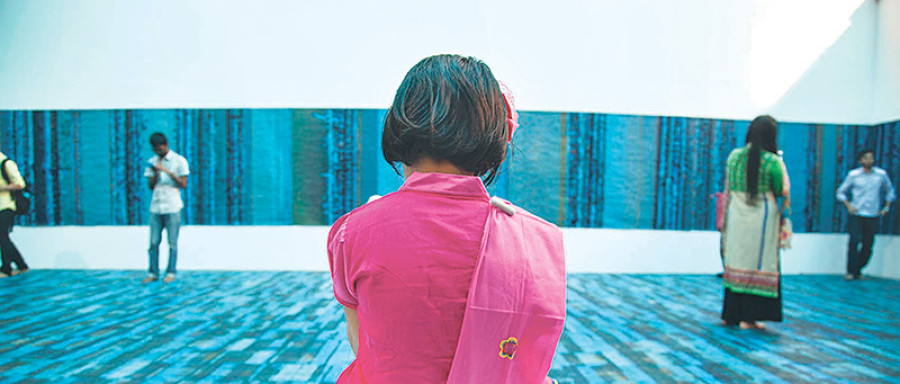Entertainment
Nepal and the globalised art world
In discussing the Dhaka Art Summit 2018 tangentially, I take my queue from Gayatri Chakravorty Spivak’s closing keynote address. Gayatri is a name familiar to Nepal’s academia, as she is to a large section of students of the humanities and social sciences.
Kurchi Dasgupta
In discussing the Dhaka Art Summit 2018 tangentially, I take my queue from Gayatri Chakravorty Spivak’s closing keynote address. Gayatri is a name familiar to Nepal’s academia, as she is to a large section of students of the humanities and social sciences. The reason I talk about her ‘talk’ is because it brings into perspective the role of large scale, recurring exhibitions in the region.
We have one of our own in Nepal, the Kathmandu Triennale. Even as the Siddhartha Foundation gears up to announce the Curator for the 2020 edition, it is perhaps time to pause and reflect upon what exactly may Kathmandu Triennale aspire to.
The 2017 iteration went with the tagline: ‘Kathmandu Triennale is Nepal’s premier international platform for global contemporary arts’. The Kathmandu Triennale is a reinvention of the Kathmandu International Art Festival (KIAF) that started in 2009. Along with the Colombo Art Biennale (CAB) that started the same year, it was a pioneering effort of sorts in the region. For the Asian Art Biennale that started as early as 1981 in Bangladesh had lost its edge, and the Triennale-India that started even earlier in 1968 had lost its relevance as a player in the global art economy.
Oikos is an ancient Greek word that has evolved into the ‘eco’ of both economics and ecology. It is a fact that though the two words share the same prefix, they are somewhat antithetical to each other in terms of ethics. In terms of the art world, they are not the best of friends either. Though ecological art is gaining currency, my focus is not that. I am more interested in the ecology of the art world here than the economy of it. That economics drives the production of art globally today is a fact we cannot bypass or ignore. As responsible inhabitants of Earth in the 21st century, we can only try and rescue it from the absolute grasp of market mechanisms and try and restore it to ecology to some extent. It is interesting that both the Kathmandu International Art Festival and the Colombo Art Biennale stepped into the international circuit in 2009. It was the year that followed the global financial crisis. Was this a coincidence? For Sangeeta Thapa, Founder Director of KIAF, the time was right because Nepal had negotiated an end to its Maoist insurgency and civil war and had become a republic just the year before. For Annoushka Hempel, Founder of CAB, it was a way to encounter officially declared peace after three decades of civil war. Both women felt a need to nurture the arts. And thereafter, the economics of it at a national and international level. It was also the year that the global economy was in such disarray that it was possible to rethink the paradigm, when the centre was loosening its hold.
But we are now in 2018. South Asia is gaining a voice in the global economy as a region, even if not equitably for all participants. It is a time when we need to rethink our strategy in terms of art making. Since 2009 Bangladesh, India and Pakistan have come up with their solid iterations of large scale regional art events. Competing with them in terms of scale and resources would be a fallacy. Instead, it would serve us better if we were to train the spotlight on the quotidian and the insignificant. Or perhaps on what Spivak calls the “small social groups on the fringes of history.” And some of our artists have already taken on the task.
I have just been to the Dhaka Art Summit and delivered a talk on its closing panel, which was surprisingly well received given that I was talking about the art scene in Nepal. The Summit was a grand event but my takeaway, from the perspective of Nepal, is that we need to veer away from the economics of art and look into the minor, regional, unheard of things to be of relevance today. Maybe if we look towards the whole of Nepal, and move our focus away from Kathmandu, we may find a shortcut to be included in the economy of global art which is always looking for the ‘fresh’ and ‘new’. Kathmandu is a bubble that has exposure to and responds to the global. It is perhaps time to move beyond it and explore what the rest of the country reveals. That is where our strength lies, and not in artworks that are created in response to global idioms.
We in Nepal are just getting trained in the idiom of a globalised art world and are beginning to get used to the language of biennales and art festivals. But even we know that it is these inter-work conversations that are of highest interest. For it is these invisible and inaudible dialogues and contrasts, when skilfully catalysed by a curator, that spark off an unlearning process in the viewers and jolt us into awareness of our social and political reality. It is these conversations that set the ball in motion for eventual, widespread changes in sensibility. When works are displayed so that they become objects or processes to be merely viewed or consumed in isolation, the justifications for a large scale recurring exhibition disappears.




 5.44°C Kathmandu
5.44°C Kathmandu










